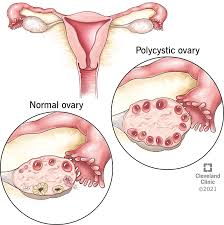Unveiling the shared genetic architecture between testosterone and polycystic ovary syndrome
Testosterone (T) is a critical predictor of polycystic ovary syndrome (PCOS) but the genetic overlap between T and PCOS has not been established. Here by leveraging genetic datasets from large-scale genome-wide association studies, we assessed the genetic correlation and polygenic overlap between PCOS and three T-related traits using linkage disequilibrium score regression and the bivariate causal mixture model methods.
The conjunctional false discovery rate (conjFDR) method was employed to identify shared causal variants. Functional annotation of variants was conducted using FUMA. Total T and bioavailable T exhibited positive correlations with PCOS, while sex hormone-binding globulin (SHBG) showed a negative correlation. All three traits demonstrated extensive genetic overlap with PCOS, with a minimum of 68% of T-related variants influencing PCOS.
The conjFDR revealed 4 to 6 causal variants within joint genomic loci shared between PCOS and T-related traits. Functional annotations suggested that these variants might impact PCOS by modulating nearby genes, such as FSHB. Our findings support the hypothesis that PCOS is significantly influenced by androgen abnormalities. Additionally, this study identified several causal variants potentially involved in shared biological mechanisms between PCOS and T regulation.
Polycystic ovary syndrome (PCOS) stands out as one of the most prevalent endocrine abnormalities, affecting 6–20% of women globally within their reproductive years. The presentation of PCOS is notably intricate and heterogeneous, with clinical diagnosis primarily relying on three key characteristics: the presence of clinical or biochemical hyperandrogenism (HA), chronic ovulatory dysfunction (OD), and ultrasound-indicated polycystic ovarian morphology (PCOM).
The 1990 US National Institutes of Health (NIH) criteria initially defined PCOS as the presence of both HA and OD, while the 2003 Rotterdam criteria expanded this definition to include the diagnosis of PCOM, requiring the presence of at least two of the three characteristics. Subsequently, mounting evidence suggested that HA might involve in major pathophysiological mechanisms underlying PCOS, leading the 2006 Androgen Excess and PCOS Society (AE-PCOS) Position Statement to assert that PCOS should primarily be considered a disorder of androgen excess or HA.
Polycystic ovary syndrome, hormonal imbalance, insulin resistance, irregular periods, ovarian cysts, infertility, acne, hirsutism, weight gain, mood swings, menstrual disorders, metabolic syndrome, reproductive health, anovulation, androgen excess, endocrine disorder, hair thinning, chronic inflammation, type 2 diabetes, lifestyle management
#PCOS, #PolycysticOvarySyndrome, #HormonalImbalance, #WomensHealth, #IrregularPeriods, #FertilityAwareness, #OvarianCysts, #EndocrineDisorder, #PCOSAwareness, #AcneProblems, #Hirsutism, #MetabolicSyndrome, #InsulinResistance, #HairThinning, #HealthyHormones, #PCOSSupport, #Anovulation, #Type2DiabetesRisk, #WeightGainStruggles, #WomensWellness
International Conference on Genetics and Genomics of Diseases
Visit: genetics-conferences.healthcarek.com
Award Nomination: genetics-conferences.healthcarek.com/award-nomination/?ecategory=Awards&rcategory=Awardee
Award registration: genetics-conferences.healthcarek.com/award-registration/
For Enquiries: contact@healthcarek.com
Get Connected Here
---------------------------------
---------------------------------
in.pinterest.com/Dorita0211
twitter.com/Dorita_02_11_
facebook.com/profile.php?id=61555903296992
instagram.com/p/C4ukfcOsK36
genetics-awards.blogspot.com/
youtube.com/@GeneticsHealthcare

Comments
Post a Comment